Automations AutomationA process that triggers actions automatically when specified conditions are met, reducing manual work.
help streamline repetitive tasks TaskSomething that needs to be done. Create and assign tasks to yourself or others, often linked to a specific Record.
by automatically performing actions when certain events occur in your collections CollectionA list of records in Kinabase, similar to a table in a spreadsheet or database.
.
By defining the 'When → Then' conditions, you can reduce manual work and keep your team in sync.
Automations let you configure trigger events (the 'when') and
resulting actions (the 'then'). For example:
✴︎ When a new record RecordAn individual entry within a Collection, like a row in a database table, representing one item or entity.
is added to a 'Maintenance' collection
→ Then create a task assigned to multiple maintenance staff, or send a notification NotificationA reminder sent by Kinabase to inform you about events, such as changes to a Record or upcoming tasks.
✴︎ When a workflow WorkflowA defined sequence of stages and actions that a Record passes through, often representing a business process.
stage StageA step in a Workflow that a Record moves through, illustrating its current status in the process.
changes to 'Approved'
→ Then generate a new record in another collection, or send an email alert
The benefits of automations:
- Automate routine tasks like creating follow-up tasks or notifications.
- Make sure boring administration tasks are never missed.
- Standardise processes and reduce manual steps.
- Keep everyone informed with automated alerts or tasks.
- Add new automations as your organisation's needs evolve.
- Click your name in the bottom-left corner of Kinabase.
- Under Organisation, choose Automations.
- Click + Add Automation in the top-right corner.
Give your automation a clear name (e.g., 'Notify Finance on New Invoices') and a brief description.
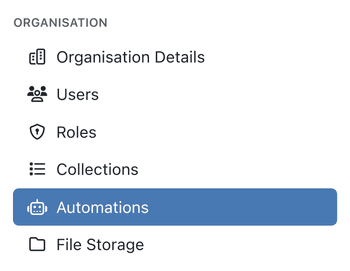
This is your 'Trigger' - when this happens, the automation runs.
You have lots of options for trigger events, for instance:
- ... A record is added to a specific collection
- ... A record is updated (general or a specific field)
- ... A record is right-clicked.
- ... A record becomes due. (If you have a date field in your record)
- ... A record changes (workflow) stage
Pick your trigger event from the dropdown menu.
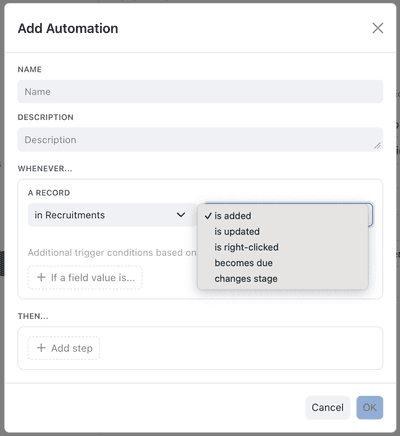
You can also set Additional Trigger Conditions based on field values.
Use the 'If field value is...' to define these.
Use these Additional Trigger Conditions to define whenever... a certain field FieldA column in a Collection that stores a specific type of information for each Record, such as text, number, or date.
meets a condition.
- You can define 'If' conditions with both '+And' and '+Or' criteria to refine when the automation runs
- You can even use the field character length for text fields.
- For example 'Only if a priority field equals 'High' and Company is 'XYZ')
Once you define the trigger, choose what Kinabase should do automatically:
- Create and assign tasks, optionally setting due dates or multiple assignees.
- Choose recipients and urgency (Urgent, High, Medium, Low).
- Specify a target collection and fill out relevant fields.
- Change fields in the same record that triggered the automation (e.g., set a status to 'In Progress').
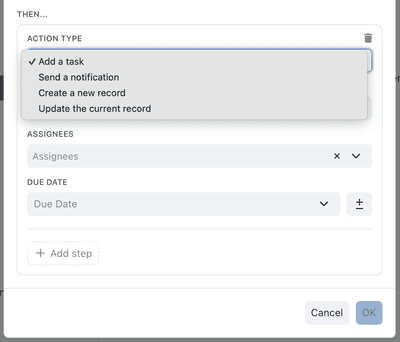
You can add multiple steps to the same automation - e.g., first send a notification, then create a new record, then add a task.
- Click 'OK' to finalise your automation.
- It takes effect immediately; any new triggers will now run the automation steps you defined.
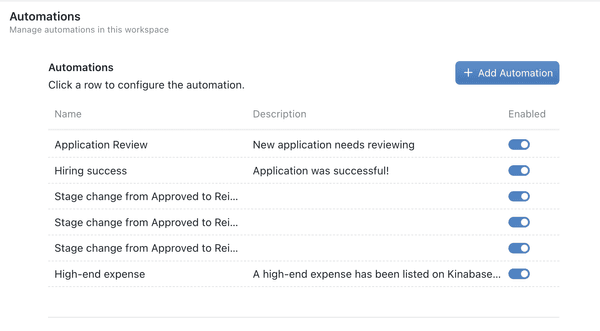
Our Automations have some advanced features that help streamline your internal operations and seamlessly take care of the busy work for you.
See below for how you can get the most out of automations:
Multiple Steps & Conditions
Enable a cascade of action steps based on your conditions & logic:
Create multiple follow-up actions. For example, after adding a task, you could also send an email notification to a manager.
Some triggers allow you to refine when an automation gets used (e.g., only if a certain field equals 'High Priority').
Some workflow stages allow you to preview which automations will run. This ensures you have full clarity on what will happen next.
Use this preview feature to confirm tasks, notifications, or record changes before finalising an action.
Assign Tasks to Multiple Users
When adding a 'Create Task' step, you can select multiple owners. All assigned users will be notified and see the task in their dashboard DashboardA page you configure with widgets, charts, and reports to monitor key metrics and data at a glance.
.
Viewing & Editing Automations
If you need to pause or change an automation, open it from the Automations list and modify or toggle it off.
Right-click & Edit an automation. Select the History tab to see a log of each time it's been triggered and the outcome.
You will also find statistics on how many times it has run successfully or failed.

If your Automation is based on times & dates - you can also see when it is next scheduled to run in the 'Scheduled' tab.
You can copy parent-record values automatically in automation field mapping.
When creating or editing an automation, you can set fields in the new record to pull values from the triggering record or other related records.
- In the Automation Editor, add or open a Record step that targets a sub-record Collection.
- In Field assignment, click the new “Copy from parent” option next to any mappable Field.
- Choose the parent Field you want and Save – Kinabase will use that value every time the step runs.
Read our Product Update for more.
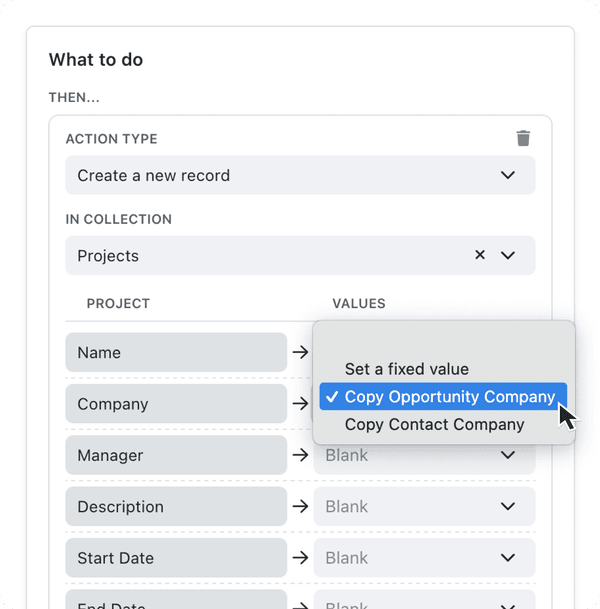
Automations can be very useful, but can become overly complicated if you're not careful. Follow the guidance below to get the most out of them:
Start simply & evolve
Start with a minimal number of automations. Overcomplicating from the get-go can lead to confusion.
It does 'what it says on the tin'
Clear automation names help your team understand their purpose straight away.
Periodically review
Check automation logs periodically to ensure everything is running smoothly.
Combine with your workflows
Automations work great with workflows - when a record moves to a certain stage, let an automation handle the follow-up tasks.
Using Automations in Kinabase saves time and maintains consistency for your team, letting them focus on the tasks that matter most.
If you need more help or have advanced scenarios in mind, check out our other guides or contact our Support Team.





